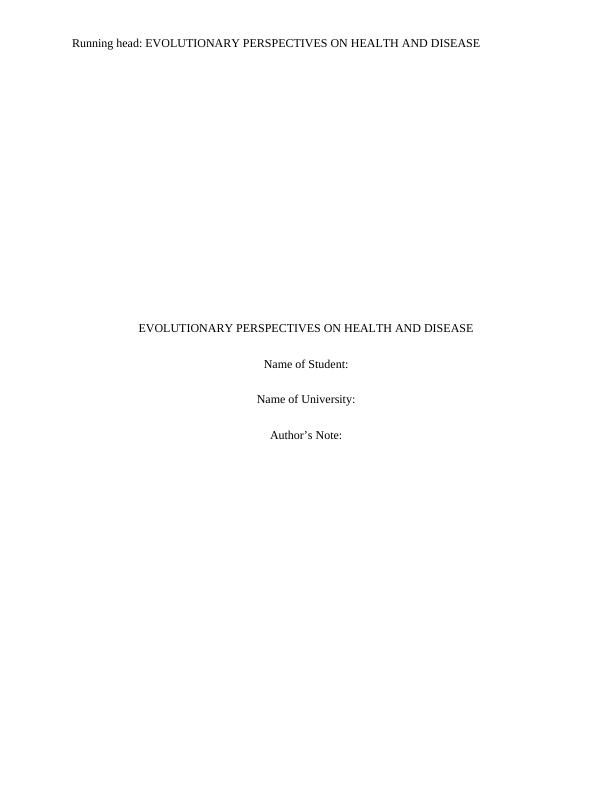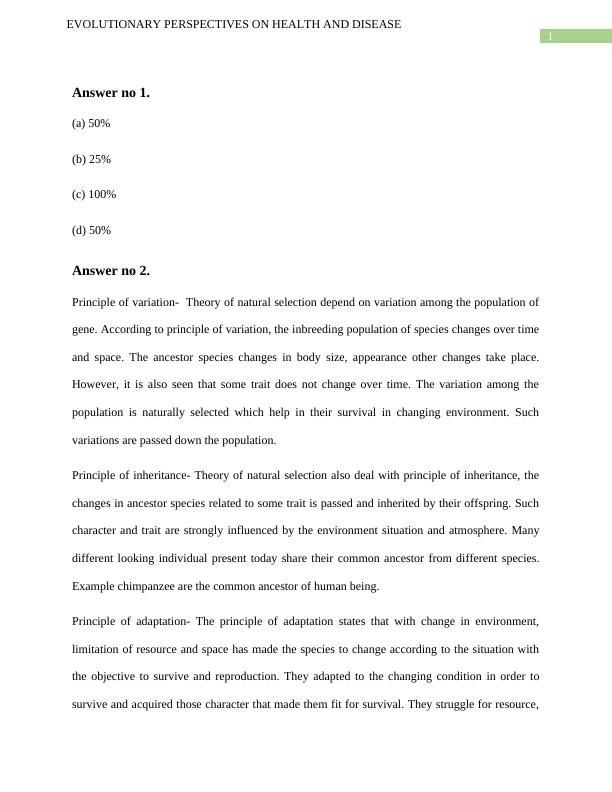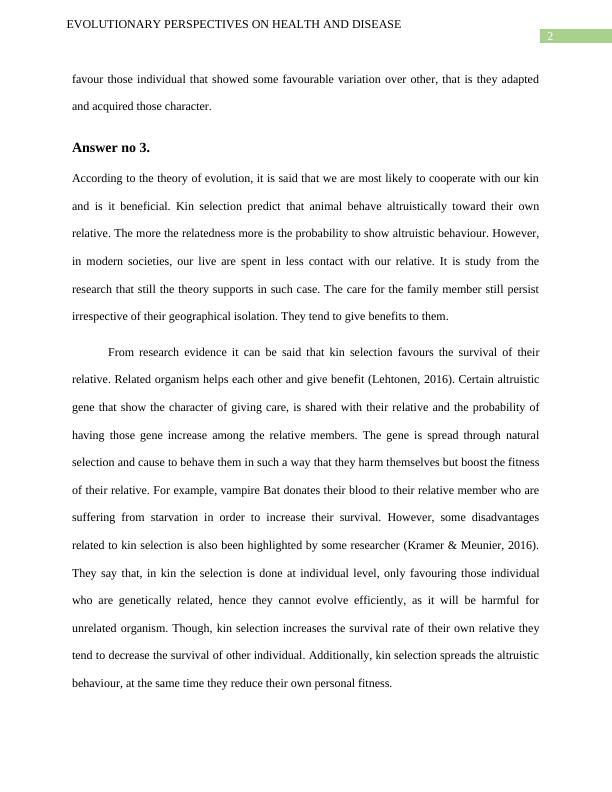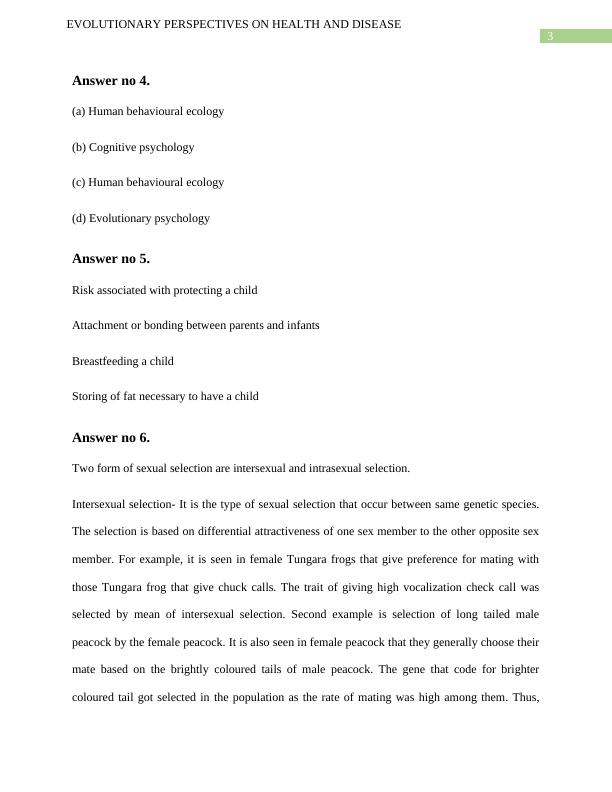Evolutionary Perspectives on Health and Disease
Added on 2023-04-19
13 Pages3440 Words256 Views
Running head: EVOLUTIONARY PERSPECTIVES ON HEALTH AND DISEASE
EVOLUTIONARY PERSPECTIVES ON HEALTH AND DISEASE
Name of Student:
Name of University:
Author’s Note:
EVOLUTIONARY PERSPECTIVES ON HEALTH AND DISEASE
Name of Student:
Name of University:
Author’s Note:

1
EVOLUTIONARY PERSPECTIVES ON HEALTH AND DISEASE
Answer no 1.
(a) 50%
(b) 25%
(c) 100%
(d) 50%
Answer no 2.
Principle of variation- Theory of natural selection depend on variation among the population of
gene. According to principle of variation, the inbreeding population of species changes over time
and space. The ancestor species changes in body size, appearance other changes take place.
However, it is also seen that some trait does not change over time. The variation among the
population is naturally selected which help in their survival in changing environment. Such
variations are passed down the population.
Principle of inheritance- Theory of natural selection also deal with principle of inheritance, the
changes in ancestor species related to some trait is passed and inherited by their offspring. Such
character and trait are strongly influenced by the environment situation and atmosphere. Many
different looking individual present today share their common ancestor from different species.
Example chimpanzee are the common ancestor of human being.
Principle of adaptation- The principle of adaptation states that with change in environment,
limitation of resource and space has made the species to change according to the situation with
the objective to survive and reproduction. They adapted to the changing condition in order to
survive and acquired those character that made them fit for survival. They struggle for resource,
EVOLUTIONARY PERSPECTIVES ON HEALTH AND DISEASE
Answer no 1.
(a) 50%
(b) 25%
(c) 100%
(d) 50%
Answer no 2.
Principle of variation- Theory of natural selection depend on variation among the population of
gene. According to principle of variation, the inbreeding population of species changes over time
and space. The ancestor species changes in body size, appearance other changes take place.
However, it is also seen that some trait does not change over time. The variation among the
population is naturally selected which help in their survival in changing environment. Such
variations are passed down the population.
Principle of inheritance- Theory of natural selection also deal with principle of inheritance, the
changes in ancestor species related to some trait is passed and inherited by their offspring. Such
character and trait are strongly influenced by the environment situation and atmosphere. Many
different looking individual present today share their common ancestor from different species.
Example chimpanzee are the common ancestor of human being.
Principle of adaptation- The principle of adaptation states that with change in environment,
limitation of resource and space has made the species to change according to the situation with
the objective to survive and reproduction. They adapted to the changing condition in order to
survive and acquired those character that made them fit for survival. They struggle for resource,

2
EVOLUTIONARY PERSPECTIVES ON HEALTH AND DISEASE
favour those individual that showed some favourable variation over other, that is they adapted
and acquired those character.
Answer no 3.
According to the theory of evolution, it is said that we are most likely to cooperate with our kin
and is it beneficial. Kin selection predict that animal behave altruistically toward their own
relative. The more the relatedness more is the probability to show altruistic behaviour. However,
in modern societies, our live are spent in less contact with our relative. It is study from the
research that still the theory supports in such case. The care for the family member still persist
irrespective of their geographical isolation. They tend to give benefits to them.
From research evidence it can be said that kin selection favours the survival of their
relative. Related organism helps each other and give benefit (Lehtonen, 2016). Certain altruistic
gene that show the character of giving care, is shared with their relative and the probability of
having those gene increase among the relative members. The gene is spread through natural
selection and cause to behave them in such a way that they harm themselves but boost the fitness
of their relative. For example, vampire Bat donates their blood to their relative member who are
suffering from starvation in order to increase their survival. However, some disadvantages
related to kin selection is also been highlighted by some researcher (Kramer & Meunier, 2016).
They say that, in kin the selection is done at individual level, only favouring those individual
who are genetically related, hence they cannot evolve efficiently, as it will be harmful for
unrelated organism. Though, kin selection increases the survival rate of their own relative they
tend to decrease the survival of other individual. Additionally, kin selection spreads the altruistic
behaviour, at the same time they reduce their own personal fitness.
EVOLUTIONARY PERSPECTIVES ON HEALTH AND DISEASE
favour those individual that showed some favourable variation over other, that is they adapted
and acquired those character.
Answer no 3.
According to the theory of evolution, it is said that we are most likely to cooperate with our kin
and is it beneficial. Kin selection predict that animal behave altruistically toward their own
relative. The more the relatedness more is the probability to show altruistic behaviour. However,
in modern societies, our live are spent in less contact with our relative. It is study from the
research that still the theory supports in such case. The care for the family member still persist
irrespective of their geographical isolation. They tend to give benefits to them.
From research evidence it can be said that kin selection favours the survival of their
relative. Related organism helps each other and give benefit (Lehtonen, 2016). Certain altruistic
gene that show the character of giving care, is shared with their relative and the probability of
having those gene increase among the relative members. The gene is spread through natural
selection and cause to behave them in such a way that they harm themselves but boost the fitness
of their relative. For example, vampire Bat donates their blood to their relative member who are
suffering from starvation in order to increase their survival. However, some disadvantages
related to kin selection is also been highlighted by some researcher (Kramer & Meunier, 2016).
They say that, in kin the selection is done at individual level, only favouring those individual
who are genetically related, hence they cannot evolve efficiently, as it will be harmful for
unrelated organism. Though, kin selection increases the survival rate of their own relative they
tend to decrease the survival of other individual. Additionally, kin selection spreads the altruistic
behaviour, at the same time they reduce their own personal fitness.

3
EVOLUTIONARY PERSPECTIVES ON HEALTH AND DISEASE
Answer no 4.
(a) Human behavioural ecology
(b) Cognitive psychology
(c) Human behavioural ecology
(d) Evolutionary psychology
Answer no 5.
Risk associated with protecting a child
Attachment or bonding between parents and infants
Breastfeeding a child
Storing of fat necessary to have a child
Answer no 6.
Two form of sexual selection are intersexual and intrasexual selection.
Intersexual selection- It is the type of sexual selection that occur between same genetic species.
The selection is based on differential attractiveness of one sex member to the other opposite sex
member. For example, it is seen in female Tungara frogs that give preference for mating with
those Tungara frog that give chuck calls. The trait of giving high vocalization check call was
selected by mean of intersexual selection. Second example is selection of long tailed male
peacock by the female peacock. It is also seen in female peacock that they generally choose their
mate based on the brightly coloured tails of male peacock. The gene that code for brighter
coloured tail got selected in the population as the rate of mating was high among them. Thus,
EVOLUTIONARY PERSPECTIVES ON HEALTH AND DISEASE
Answer no 4.
(a) Human behavioural ecology
(b) Cognitive psychology
(c) Human behavioural ecology
(d) Evolutionary psychology
Answer no 5.
Risk associated with protecting a child
Attachment or bonding between parents and infants
Breastfeeding a child
Storing of fat necessary to have a child
Answer no 6.
Two form of sexual selection are intersexual and intrasexual selection.
Intersexual selection- It is the type of sexual selection that occur between same genetic species.
The selection is based on differential attractiveness of one sex member to the other opposite sex
member. For example, it is seen in female Tungara frogs that give preference for mating with
those Tungara frog that give chuck calls. The trait of giving high vocalization check call was
selected by mean of intersexual selection. Second example is selection of long tailed male
peacock by the female peacock. It is also seen in female peacock that they generally choose their
mate based on the brightly coloured tails of male peacock. The gene that code for brighter
coloured tail got selected in the population as the rate of mating was high among them. Thus,

End of preview
Want to access all the pages? Upload your documents or become a member.
Related Documents
Evolutionary Perspectives on Health and Diseaselg...
|7
|1518
|69
Environmental Science Assignment - Doclg...
|11
|3388
|461
THE EVOLUTIONARY GENETICSlg...
|11
|3835
|19
Genetics HBSS Research Paper 2022lg...
|5
|981
|19
Psychology: Evolution, Behavior and Respondent Conditioninglg...
|8
|1362
|494
Evolution and Darwin’s Theorylg...
|5
|961
|375
